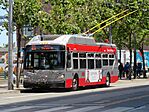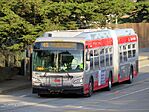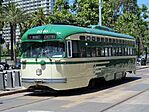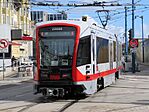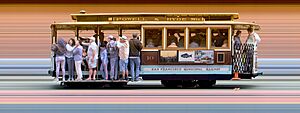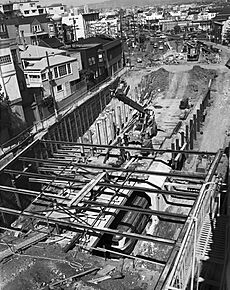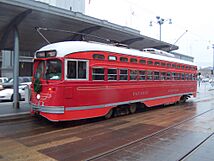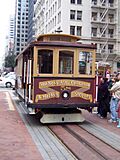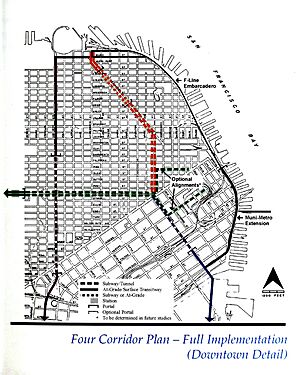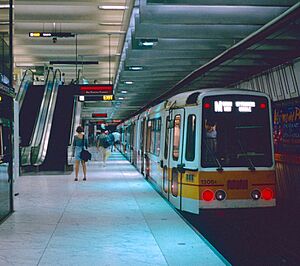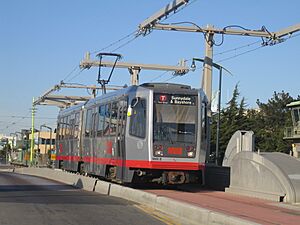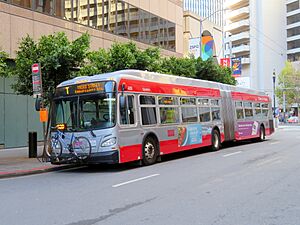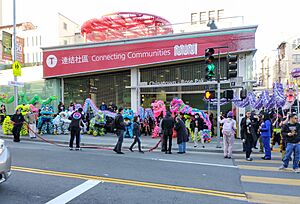San Francisco Municipal Railway facts for kids
Quick facts for kids San Francisco Municipal Railway |
|
|---|---|
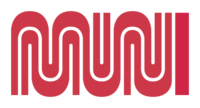 |
|
| Info | |
| Owner | San Francisco Municipal Transportation Agency |
| Locale | San Francisco |
| Transit type | Bus, trolleybus, light rail, streetcar, cable car |
| Number of lines | 83 |
| Chief executive | Julie Kirschbaum (Director of Transportation, SFMTA) |
| Operation | |
| Began operation | December 28, 1912 |
| Technical | |
| Track gauge | 4 ft 8 1⁄2 in (1,435 mm) standard gauge (light rail, streetcars) 3 ft 6 in (1,067 mm) (cable cars) |
| Electrification | Overhead line, 600 V DC |
| Average speed | 8.1 mph (13.0 km/h) |
The San Francisco Municipal Railway, often called Muni, is the main public transportation system in San Francisco, California. It runs many different types of vehicles. These include bus routes (some are trolleybuses), the Muni Metro light rail system, three historic cable car lines, and two historic streetcar lines.
Muni used to be its own agency. In 1999, it joined with two other groups. They formed the San Francisco Municipal Transportation Agency (SFMTA). In 2018, Muni served an area of about 46.7 square miles. It had a budget of about $1.2 billion. Muni is one of the busiest transit systems in the United States. It is the second busiest in California.
Contents
How Muni Works
Most Muni buses run every 5 to 15 minutes during busy times. They run every 5 to 20 minutes in the middle of the day. At night, they run about every 10 to 20 minutes. Late-night "owl" routes run about every half-hour. On weekends, most buses run every 10 to 20 minutes.
Sometimes, buses are not on time. This is especially true for lines that run less often. Muni aims for 85% on-time service. But it has had trouble reaching this goal.
All Muni lines stay within San Francisco city limits. A few lines go into northern Daly City. The 76X Marin Headlands Express line goes to the Marin Headlands on weekends. Other ways to travel between cities are by BART and Caltrain trains. Also, AC Transit, Golden Gate Transit, and SamTrans buses connect downtown.
Bus and cable car stops vary across the city. Some are Metro stations with raised platforms. Others are small shelters or just signs on poles. About 70% of stops are closer than recommended.
Muni's Name and Logo
The system is commonly known as "Muni." This is a shorter way to say "Municipal" from its full name. Muni's logo is a special "worm" design of the word muni. A designer named Walter Landor created this logo in the mid-1970s.
Announcements on Board
Muni buses make announcements in four languages. These are English, Spanish, Cantonese, and Tagalog. This helps serve the many Hispanic and Latino American and Asian American people in San Francisco.
Route Names
Bus and trolleybus lines have a number and a name. The name usually comes from a main street they travel on. For example, the 1-California line runs mostly along California Street.
Rail lines have letters and names. Examples are J-Church and N-Judah. The three cable car lines are known by their names only. These are Powell-Mason, Powell-Hyde, and California.
Fares
Most Muni rides cost $3.00 for adults if you pay with cash. For seniors (over 65), people with disabilities, and Medicare card holders, it's $1.50. Low-income seniors, youth 18 and under, and San Francisco residents with disabilities ride for free.
If you use a Clipper card or the MuniMobile app, adult fares are $2.75. For seniors and people with disabilities, it's $1.25. You can use a Clipper card, MuniMobile, a Muni Passport, or a paper transfer as proof of payment. One fare lets you transfer to other vehicles for 120 minutes.
Cable cars cost $9 for a one-way trip. You cannot use regular transfers on cable cars. However, Muni Passports or monthly passes work on them. As of July 2019, a monthly pass for adults cost $81. A pass with BART access within the city cost $98.
"Passports" are special passes you can buy. They let you ride all regular Muni lines, including cable cars, without extra fees. In September 2018, a 1-day pass cost $23. A 3-day pass was $34, and a 7-day pass was $45. You could get discounts using a Clipper card or MuniMobile.
Muni uses a smart card system called Clipper. This system replaced most paper monthly passes in 2010. Other transit agencies in the Bay Area also use Clipper.
You can also pay fares using the MuniMobile app. This app was launched in 2015.
Special Services
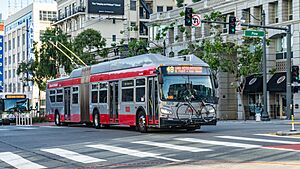
Muni has special services like express, rapid, and owl lines. There are 14 express lines, 5 rapid lines, and 12 owl lines. Owl lines run late at night, from 1 AM to 5 AM. For San Francisco Giants baseball games, extra "baseball shuttles" help people get to Oracle Park.
Express lines run only during busy rush hours. In the mornings, they go towards downtown. In the evenings, they go away from downtown. These lines have an "X," "AX," or "BX" after their number. Rapid lines (with an "R" after their number) make fewer stops. They usually stop every third stop or at transfer points.
Cable Car System
Muni also runs the San Francisco cable car system. These are historic cable cars that are pulled by underground cables. The city bought its first cable car line in 1906. The current system has been running since 1952. It was named a National Historic Landmark in 1964.
There are three cable car lines: Mason-Powell, California State, and Powell-Hyde. They serve popular areas like the Embarcadero and Fisherman's Wharf. The system has 62 stations. About five million people ride the cable cars each year. They are popular with tourists and locals.
Heritage Streetcars
Muni also operates two heritage streetcar lines. These are different from the Muni Metro light rail. They are the E Embarcadero and F Market & Wharves lines. The E Embarcadero line was stopped in April 2020 due to the COVID-19 pandemic. These streetcars started regular service in 1995. They do not use tunnels. The F line uses tracks on Market Street that were once for other streetcar lines.
Statistics
The longest Muni line is the 24.1-mile (38.8 km) 91 Owl. This is a night-only route that combines parts of other routes. The longest daytime route is the 17.4-mile (28.0 km) 29 Sunset. The shortest route is the 88 BART Shuttle at 1.4 miles (2.3 km). The steepest hill climbed by a Muni bus is 23.1%. A cable car climbs a 21% grade on the Powell-Hyde line.
The busiest Muni bus area is the Geary corridor. The 38 Geary and 38R Geary Rapid routes travel 6.5 miles (10.5 km) along Geary. They have an average speed of only 8 miles per hour (13 km/h). In 2015, this area had 55,270 average daily riders.
At Powell and Market Streets, three types of rail gauges are close to each other. These are for Bay Area Rapid Transit (BART), Muni Metro, and the San Francisco cable car system. The F Market and Wharves heritage streetcar line is also there. The different rail lines do not cross each other.
Muni's Fleet of Vehicles
Muni uses about 1,200 vehicles. This includes 550 diesel-electric hybrid buses. There are also 300 electric trolleybuses. Muni has 250 modern light rail vehicles and 50 historic streetcars. There are also 40 cable cars. All vehicles, except cable cars, can be used by people in wheelchairs.
The electricity for Muni's trolleybuses, light rail vehicles, streetcars, and the cable car powerhouse comes from the Hetch Hetchy Reservoir. This is a hydroelectric dam in Yosemite National Park.
All of Muni's current buses use diesel-electric hybrid engines. They run on renewable diesel fuel. This fuel is made from plant and animal fats. This helps reduce fuel use and pollution.
How Well Muni Performs
In November 1999, San Francisco voters passed Proposition E. This set a goal for Muni to be on time at least 85% of the time. In July 2012, Muni vehicles were on time 60% of the time. In August 2012, they were on time 57% of the time. A report in early 2013 showed Muni was on time only 58% of the time. This caused delays for customers and affected the city's economy. By March 2014, on-time performance was 60%.
As of June 2022, Muni Metro's on-time performance varied by line. For example, the N-Judah line was on time 61.7% of the time. The K/T Ingleside/Third Street line was on time 51.3% of the time. Overall, all Muni Metro lines were on time 57.7% of the time.
How Muni is Managed
Since November 1999, Muni has been part of the San Francisco Municipal Transportation Agency (SFMTA). This is a city agency created by a vote. Muni, the Department of Parking and Traffic, and the Taxicab Commission joined together. A board of seven directors leads the SFMTA. The Mayor appoints them, and the Board of Supervisors confirms them.
Jeffrey Tumlin became the new Director of Transportation for SFMTA on December 16, 2019. The daily operations of Muni are managed by the Transit division of the SFMTA. Julie Kirschbaum is currently the Director of Transit.
Muni's History
Early Years
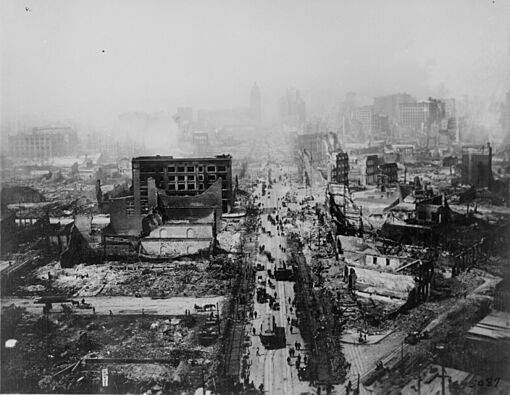
Muni started after the 1906 San Francisco earthquake. Before that, several private companies ran horse-drawn cars, cable cars, and electric streetcars. Many of these joined to form the United Railroads of San Francisco (URR). In 1909, voters approved a city-owned rail line. In 1912, the city took over the Geary Street cable car line. It turned it into an electric streetcar line. This was Muni's first line.
Muni quickly began building more lines. In 1914, the Stockton Street Tunnel opened. This allowed streetcars to reach North Beach. It also served the Marina District, where the 1915 Panama-Pacific International Exposition was held.
In 1918, the Twin Peaks Tunnel opened. This helped develop the southwestern part of the city. In 1928, the Sunset Tunnel opened. This brought the N Judah streetcar line to the Sunset District. These improvements made Muni compete directly with the URR on Market Street.
1940s: First Trolleybuses
In 1941, Muni introduced its first trolleybus line. Trolleybuses had been in San Francisco since 1935. But they were run by a private company. By 1944, this company had money problems. So, on September 29, 1944, Muni bought its competitor. Muni took over their routes and equipment.
After this, Muni replaced most of its rail lines with trolleybus service. A few lines with their own tracks, like those through the Twin Peaks and Sunset tunnels, stayed as rail lines. These lines later became the start of the Muni Metro.
During World War II, many men went to serve in the military. So, both Muni and the private company hired women as 'motorettes' (drivers) and conductors. One famous person was the poet Maya Angelou, who worked for Muni in 1943.
1970s and 1980s: Building and Changes
In the 1950s and 1960s, the regional BART system was planned. It was thought BART would provide local train service in San Francisco. Because of this, Muni's own system did not get enough new improvements.
Construction on BART's Market Street tunnel began in 1967. It had two levels of tracks. The upper level was meant for local service. But BART had high costs. So, in 1969, the state government helped save the project. Local service in San Francisco was cut. The partially built stations became the basis for a new light-rail subway called the Muni Metro. This connected downtown stations to the Twin Peaks Tunnel.
Construction on the Muni Metro started in 1970. But it faced more cuts and changes. The Muni Metro finally opened in February 1980. The first line was N-Judah. Other lines followed later in 1980. However, the many changes led to long-term problems.
In 1981–1982, Muni had a problem with its diesel buses. Many of them were old and needed to be replaced. But there was no money to buy new ones. Muni used trolleybuses more to help. They also decided to buy buses at different times. This would prevent many buses from getting old at the same time.
In September 1982, the cable car system closed for 21 months for repairs. After this, the lines were changed to improve service across the city.
In 1983, Muni ran historic streetcars on Market Street. This was part of the San Francisco Historic Trolley Festival. It was a temporary attraction while the cable cars were being rebuilt. People loved it so much that the festival continued for several years. Muni began fixing tracks in 1987. This led to the opening of the F line in 1995.
The first modern Muni bus shelter was put up in 1987.
1990s: The "Muni Meltdown"
The F line was brought back in 1995 as a heritage streetcar service. It was first meant to be a temporary tourist attraction. But it became a permanent part of Muni. The E line service started in January 1998.
In 1995, a plan called The Four Corridor Plan was released. It aimed to extend Muni Metro service along four major routes. These routes were Bayshore, Geary, North Beach, and Van Ness. These plans have since been put into action. Some are light rail lines, and others are bus rapid transit lines.
In the late 1990s, Muni had old equipment and poor management. Its service became known for being unreliable. In 1996, a group called Rescue Muni formed. They wanted to improve Muni. They supported Proposition E in 1999. This led to the creation of the San Francisco Municipal Transportation Agency. It also set service standards for Muni.
In August 1998, Muni Metro had a big problem. It switched to a new automatic train control system. This led to an event known as the Muni Meltdown. Trains were delayed and stopped. Riders were very frustrated. The Mayor even rode a train to see the chaos.
During the Meltdown, two reporters raced. One took the train, and the other walked. They tied, finishing in 23 minutes. The Mayor also tried the race. By then, Muni Metro service had improved. Train passengers finished in just seven minutes. Muni officials apologized for the difficult change. They called it "the biggest fiasco in the railway's history."
To improve service, Muni started replacing its old light rail vehicles. They bought newer ones from Italy in late 1996. They also replaced old trolleybuses and diesel buses.
2000s
Construction on a sixth light rail line finished in December 2006. This new line, called the T Third Street, opened on April 7, 2007. It had 19 new stations at street level.
In 2007, Muni's cable car signs won an award for best print promotion. On November 15, 2007, city officials looked into adding double-decker buses to Muni's fleet. A test period ran from December 2007 to January 2008.
On December 1, 2007, Mayor Gavin Newsom announced that all city vehicles, including Muni buses, would use biodiesel. This fuel is 80% petroleum diesel fuel and 20% biofuel. It helps reduce carbon emissions.
On July 17, 2009, a Muni light rail vehicle crashed into another. This injured 48 people.
On December 5, 2009, the Muni system made its biggest changes in over 30 years. This was to help with budget problems. Over 60% of bus and light rail routes changed. Six bus routes were removed. Service became less frequent on some lines. But some busy lines, like the 38 Geary, had more service.
2010s
The 2010s began with big cuts to Muni service. But later, much of the service was brought back with more funding. Improvements continued throughout the decade. The "Muni Forward" project was launched. All-door boarding was also introduced.
In 2011, Ed Reiskin became the new head of the SFMTA. The "Transit Effectiveness Project," later called "Muni Forward," aimed to improve Muni service. In April 2015, Muni Forward began. It changed route names, redesigned the system map, and increased service on busy bus routes. It also added transit signal priority, bus bulbs, and bus-only lanes.
On July 1, 2012, Muni was the first transit agency in North America to allow all-door boarding. This means riders can enter through any door on buses and trains.
Muni ordered 175 new Siemens S200 light rail cars in 2014. The first new cars arrived in November 2017. The plan was to replace the entire fleet by 2027. These new trains also provide service for the Central Subway and the Mission Bay area. Muni also bought new buses and replaced most of its old diesel and trolleybuses.
2020s
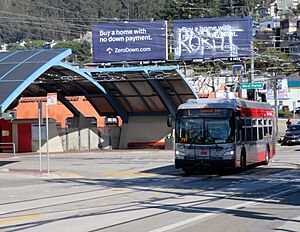
During the COVID-19 pandemic, ridership dropped a lot. Muni Metro services were replaced by buses in March 2020. By April 6, service was cut on most routes. Jeffrey Tumlin, Muni's Director, called it "the worst Muni service since 1906."
Light rail service briefly started again in August 2020. But it stopped after only three days. This was because of problems with overhead wires and a COVID-19 case in the control center. The wire problems meant passengers could get stuck in trains.
More bus routes were brought back in late 2020 and 2021. This helped with overcrowding. On September 19, 2020, the 30-Stockton line was extended. Light rail service on the J Church resumed on December 19, 2020. The T Third Street light rail service resumed on January 23, 2021.
N Judah, K/T Ingleside/Third Street, and S Shuttle subway service resumed on May 15, 2021. The F Market & Wharves historic streetcar service also resumed. M Ocean View rail service resumed on August 14, 2021.
Van Ness Bus Rapid Transit service began on April 1, 2022.
System Expansion
Muni Metro and Rail Service
Muni is planning and building new projects to expand its Metro and rail service. Many projects are also improving existing lines. A study in 2016 suggested improvements through 2050. These could cost $9–16 billion. The ConnectSF project identified new areas for subway and rapid transit. These include Geary Boulevard and 19th Avenue. An extension of the Central Subway to Fisherman's Wharf is also being considered.
Improvements for the L Taraval line are being built and should finish in 2024. Plans for the J, K, and M lines have also been approved. Construction for some of these began in 2024. Future improvements for the N Judah line are also planned. The long-term goal is to run three-car trains on this line.
Central Subway
An underground extension for the T line opened on November 19, 2022. It took ten years to build. Full service began on January 7, 2023. This project is called the Central Subway. It has three new underground stations. These are at Moscone Center, Union Square, and Chinatown. There is also one above-ground station at 4th and Brannan Streets. This project cost about $1.95 billion.
Muni is also thinking about extending the T Third project further. This could go into North Beach and Fisherman's Wharf. Or it could go to the Marina District and The Presidio. Planning for this extension started in late 2018.
Buses and Streetcars
The average speed of Muni vehicles has been getting slower. This is because of more traffic. Now, vehicles average only 8 miles (13 km) per hour. To fix this, Muni started plans to make its vehicles move faster. The Muni Forward project began in May 2006. It looked at the whole Muni system. It aimed to find ways to make service faster and more reliable.
For streetcar service, Muni is looking at extending the E Embarcadero and F Market and Wharves lines. This could go into Mission Bay and the Fort Mason Tunnel. The existing F Market & Wharves service will also be improved.
Muni also plans to expand trolleybus service. Several existing trolleybus lines might be extended. For example, the 14-Mission service could go to the Daly City BART station. Other plans include changing some diesel bus lines to electric trolleybus lines.
Images for kids
See also
 In Spanish: Ferrocarril Municipal de San Francisco para niños
In Spanish: Ferrocarril Municipal de San Francisco para niños
- Key System
- Market Street Railway Company
- San Francisco cable car system
- Trolleybuses in San Francisco


